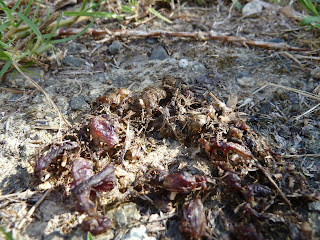Just Another Maggot Monday...
This Easter Monday ima go all David Attenborough on you...
Finding
myself at a bit of a loss of what to do I started the day by doing some
observation in my garden. Lets not go into detail as to how exactly the
pile of maggot infested rotting flesh came to be on the lawn -I thought
it might make good bird food but the local chicks weren't interested at
all (probably full of old pasta I chucked out earlier); the ants
however, were. Oh and a fruit fly eventually wandered along for a nosey but that doesn't really count does it? Wait lemme go check...
Common house fly is:
| Order: | Diptera |
| Section: | Schizophora |
| Family: | Muscidae |
| Genus: | Musca |
| Species: | M. domestica |
Whereas "Fruit" flies are:
|
|||||||
| Species: D. melanogaster | |||||||
| I guess the answer is yes (they're a type of fly) AND no (they're not in the muscidae family), I tend to think of flies as Musca. (Oooo and did you know there is a star constellation called Musca? Yeah, it's that little bunch of stars just below Crux, the Southern Cross!) | |||||||
| I'm
not sure what the green flies were doing, I didn't see them laying eggs
as they seemed more concerned with chowing down on the slimy goodness
like it was going out of season -which it is really, this being a drought and all. What was most interesting was the tiny parasitic wasp that showed up quite early on and proceeded to haphazardly and tirelessly thrust her ovipositor into each and every poor, unsuspecting maggot. The theory being that her offspring will, quite literally eat the host maggot from the inside out. Helped along by polydnaviruses, ovarian proteins, and venom injected with the egg to assist in overcoming the maggot's immune defence system. She kept up this racket for the whole half hour I watched. | |
| And
then there was the little beetle. I have nothing more to say about the
beetle. It just was. It wandered past with no intent except, presumably,
to get where it was going. Let me finish with the ants. Perhaps I should've started with them, ubiquitous as they are, scurrying across the hard, sun baked clay. On a normal day all you have to do is bend down and peer into the remnants of grass stubble. One or two bumped stumbled across the writhing mass, followed by more. They soon got a trail started. Their little anty pheromones screaming "Food! Food! Food!" to each passing comrade. It started out slowly but as each unsuspecting maggot swerved but a millimetre too far off the festering pile, it was pillaged by a black ant who triumphantly hoisted it aloft and carried it away to certain doom. This went on for quite some time as the ants didn't seem too sure what to make of the maggot pile at first but as the weaklings were separated from the herd the ants became braver and more heroic in their endeavours. Dehydration took effect and after some hours I came back to see a lattice-like shell of jerky with the odd ant still running to and fro joyously revelling in his conquest of half a shrivelled maggot. I wonder what, if anything, will be left by the morning? | |





